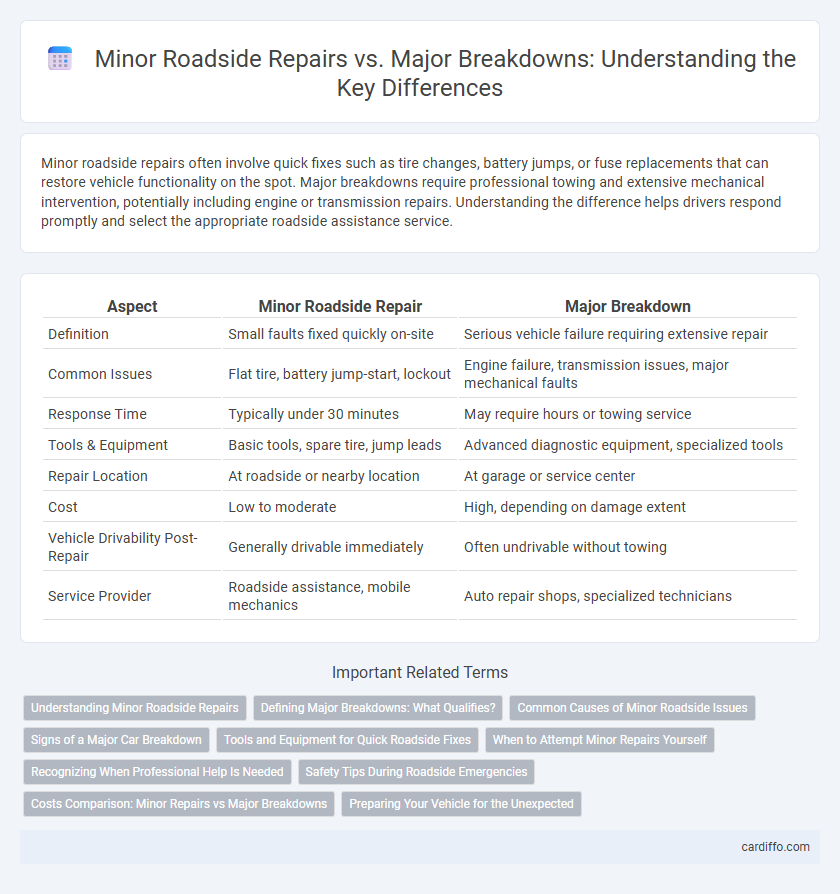Minor roadside repairs often involve quick fixes such as tire changes, battery jumps, or fuse replacements that can restore vehicle functionality on the spot. Major breakdowns require professional towing and extensive mechanical intervention, potentially including engine or transmission repairs. Understanding the difference helps drivers respond promptly and select the appropriate roadside assistance service.
Table of Comparison
| Aspect | Minor Roadside Repair | Major Breakdown |
|---|---|---|
| Definition | Small faults fixed quickly on-site | Serious vehicle failure requiring extensive repair |
| Common Issues | Flat tire, battery jump-start, lockout | Engine failure, transmission issues, major mechanical faults |
| Response Time | Typically under 30 minutes | May require hours or towing service |
| Tools & Equipment | Basic tools, spare tire, jump leads | Advanced diagnostic equipment, specialized tools |
| Repair Location | At roadside or nearby location | At garage or service center |
| Cost | Low to moderate | High, depending on damage extent |
| Vehicle Drivability Post-Repair | Generally drivable immediately | Often undrivable without towing |
| Service Provider | Roadside assistance, mobile mechanics | Auto repair shops, specialized technicians |
Understanding Minor Roadside Repairs
Understanding minor roadside repairs involves recognizing issues like flat tires, dead batteries, and loose belts that can often be fixed quickly with basic tools or roadside assistance. These repairs typically require less time and cost compared to major breakdowns, which may involve engine failure, transmission problems, or electrical system malfunctions. Promptly addressing minor repairs can prevent escalation into major breakdowns, ensuring vehicle safety and reducing towing expenses.
Defining Major Breakdowns: What Qualifies?
Major breakdowns refer to significant vehicle malfunctions that prevent safe or efficient driving, often involving critical engine, transmission, or electrical system failures. These incidents typically require professional towing services and extensive repairs at a garage, distinguishing them from minor roadside repairs which involve quick fixes like tire changes or battery jumps. Identifying a major breakdown involves assessing symptoms such as continuous engine stalling, severe overheating, or loss of power steering, indicating serious mechanical issues beyond basic roadside assistance.
Common Causes of Minor Roadside Issues
Minor roadside repairs often stem from common causes like flat tires, dead batteries, or overheating engines, which can typically be resolved with basic tools and roadside assistance. Issues such as punctured tires from sharp objects, drained battery from leaving lights on, and coolant leaks causing engine temperature spikes rank as leading triggers for minor roadside incidents. Understanding these frequent causes helps drivers prepare necessary equipment and preventive measures to avoid escalation into major breakdowns.
Signs of a Major Car Breakdown
Signs of a major car breakdown include persistent engine overheating, sudden loss of power, and unusual smoke from the exhaust or under the hood. Unlike minor roadside repairs such as tire changes or jump-starts, these symptoms signal more severe mechanical or electrical failures requiring professional assistance. Immediate attention to these signs can prevent further damage and ensure driver safety.
Tools and Equipment for Quick Roadside Fixes
Minor roadside repairs typically require basic tools and equipment such as a tire inflator, jumper cables, a wrench set, and a portable car jack, enabling quick fixes like flat tires, dead batteries, and loose bolts. Major breakdowns demand specialized diagnostic devices, heavy-duty towing equipment, and replacement parts, which are often beyond the scope of standard roadside assistance kits. Efficient roadside repair depends heavily on the availability of the right tools to address the issue promptly and minimize vehicle downtime.
When to Attempt Minor Repairs Yourself
Attempt minor roadside repairs yourself when the issue involves simple tasks such as changing a flat tire, jump-starting a battery, or replacing a blown fuse, as these require minimal tools and reduce waiting times. Avoid attempting repairs that involve complex engine problems, transmission issues, or significant mechanical failures, which demand professional diagnostics and equipment. Understanding your vehicle's manual and carrying a basic emergency repair kit enhances the safety and effectiveness of minor roadside interventions.
Recognizing When Professional Help Is Needed
Minor roadside repairs often include tasks like changing a flat tire, jump-starting a battery, or tightening loose connections, which vehicle owners can typically handle with basic tools and knowledge. Major breakdowns, involving engine failure, transmission issues, or significant electrical faults, require immediate professional assistance to ensure safety and proper diagnosis. Recognizing when a problem exceeds DIY capabilities is crucial to avoid further damage and ensure timely, effective roadside support.
Safety Tips During Roadside Emergencies
During roadside emergencies, distinguishing between minor repairs and major breakdowns is crucial for safety. For minor roadside repairs, ensure your vehicle is well off the road, use hazard lights, and place warning triangles to alert oncoming traffic. In cases of major breakdowns, remain inside the vehicle if safe, contact emergency roadside assistance promptly, and avoid attempting complex repairs to minimize risk.
Costs Comparison: Minor Repairs vs Major Breakdowns
Minor roadside repairs typically cost between $50 and $200, covering issues like tire changes, battery jumps, or fuse replacements. Major breakdowns often result in expenses exceeding $500, including towing, extensive mechanical repairs, and parts replacement. Comparing costs highlights the importance of regular maintenance to prevent costly breakdowns and reduce roadside assistance expenditures.
Preparing Your Vehicle for the Unexpected
Regular vehicle maintenance reduces the risk of minor roadside repairs, such as tire punctures or battery failures, by ensuring key components remain in good condition. Preparing an emergency roadside kit, including tools, jumper cables, and a spare tire, helps drivers handle minor repairs without professional assistance. For major breakdowns, having access to a reliable roadside assistance service and maintaining updated vehicle insurance can minimize downtime and expedite recovery.
Minor Roadside Repair vs Major Breakdown Infographic

 cardiffo.com
cardiffo.com